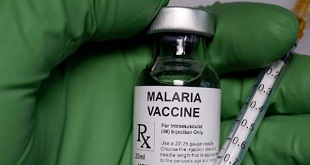Sibomana showes WFP maize stock left over
At the school, the pupils were on holiday but Sibomana proudly showed the WFP delegates maize stock left-over from parent contributions of the previous term. Sibomana says the school administrators had never anticipated a situation where a term would end with them remaining with surplus in the store. He says the ability to store food has given them new ideas. They now want to acquire another silo and plant food on the unused school land for the children.
According to WFP, over 250 schools in both Busoga and the western district of Kasese have acquired the metallic silos to keep grains for their school children’s food.
Silos are a necessity
Brett Rierson, the head of WFP’s Global Post-Harvest Knowledge and Operations Centre in Kampala explained to The Independent why the UN agency introduced the post harvest loss control initiative.
About eight years ago, Rierson said, WFP introduced the Purchase for Progress project where it had a target of procuring grains, cereals and pulses from Uganda’s smallholder farmers. But despite coming up with this initiative, WFP last year got US$70 million worth of grain and only 22% or $15 million worth of that came from smallholder farmers. Rierson says WFP realised quickly that they had only built the middle part of the value chain and that there was need for a pragmatic approach.
“We thought we should integrate backwards by going to the farmers at household level because we were concentrating at community level then,” he says, “This in a way has been solving a problem in our procurement process.”
The WFP adopted the technology from Latin America where 30 years ago the Swiss Development Cooperation initiated the hermetic storage silos and succeeded. WFP got the designs and the training manuals and customized them for Ugandan smallholder farmers.
In 2013, WFP carried out a pilot involving 250 farmers using simple technologies such as the airtight metal and plastic silos and it was discovered that these technologies can cut household post-harvest losses by up to 98%. The pilot took place in Soroti, Amuria, Gulu and Pader. The following year, the initiative was spread to 22 districts covering 16,000 farmers. In 2015, 40,000 farmers were covered in 25 districts and this year; WFP is bringing 10 more districts and 60,000 farmers on board.
“What WFP wants is to increase linkages in the private sector in order to maximize the benefits with the small-holder farmers,” says Rierson.
According to him, WFP will only consider this initiative a success if a healthy partnership develops where grain silos are brought to the farmers through silo suppliers like Akorion or Smile Plastics and not via WFP.
“WFP has reached about 10% of the farmers through private sector players but the remaining 90% need to be reached.”
Rierson says WFP is also looking at partnering with the government by training extension workers so that they continue propagating this information across Uganda.
He says within the next three years, WFP’s target is to have over 240,000 smallholder farmers participate in the zero food loss programme.
More or less
Johnson Kagoye, a Programme Officer at WFP Uganda also told The Independent that they are still just scratching the surface because there are over five million farming households in Uganda.
“WFP can be in this for as long as it has got the money but what happens after that?”
Joseph Kyegombe, the programme manager at Action for Relief and Development, a local NGO that works with WFP in Busoga and Bukedi sub-regions says the NGO joined the initiative in 2014 and trains small groups of 50 farmers. After the training a farmer orders for the appropriate equipment; either super grain bags, plastic or metallic silos.
A large metallic 1250 litre silo goes for $160, a smaller one (750 litres) goes for $120; the 500 litre plastic silos go $78 while a set of four super grain bags go for $19. Currently, WFP subsidizes the cost of each of this equipment up to 50%. These silos are accompanied with tarpaulins on which the crops are to be dried. “
We don’t want the grain to come into contact with the soil because we are trying to avoid the fungi that cause aflatoxins from getting in contact with the grains,” says Kagoye, “Aflatoxins are very dangerous because they cause cancer of the brain and among children they cause brain damage.”
Zilla Mary Arach, the Operations Manager for Akorion, an agro-inputs company based in Kampala says the farmers are profiled based on the production capacity depending on size of their land.
“Someone with half an acre who harvests 70kg of maize or beans cannot for instance go for big storage equipment of say one tonne. He or she will probably need the small super grain bags.”
Simon Cammelbeeck, the Country Director of WFP Zambia told The Independent that “the lesson from Uganda is that although it is nice to pilot things and new technologies, sometimes you need to facilitate the concept to take off through subsidies.”
Cammelbeeck says, however, it appears the cost of the hermetic technology remains a challenge for the average farmer. He had listened to Mbowa plead with WFP to give him another subsidy to buy another metallic silo to increase his storage capacity. WFP is only able to subsidize each farmer with one piece of storage equipment.
“The increase in profit after buying the silos should be convincing for the farmer to buy more silos but they are still on the high side for an average farmer when it comes to pricing,” Cammelbeeck says.
White elephant syndrome
In a separate interview, Victoria Sekitoleko, a former agriculture minister and technocrat at the UN’s Food and Agriculture Organization told The Independent on May 20 about lessons she learned from working on a similar programme. As minister of Agriculture, she introduced a home grown post-harvest loss reduction solution: large earthen pots made in such a way that if heated a little and covered well, they would safely keep the farmer’s seed for up to a year.
Rural women were enthusiastic and were willing to contribute the labour required to make the pots. They even allowed the small doors of their kitchens to be broken so the pots could be moved in. Then one year later, Sekitoleko asked her mother— one of the beneficiaries— how her seed was doing.
Sekitoleko told The Independent her mother confessed that the women in her village were never interested in the pots for saving seed but saw an opportunity to get the big capacity pots for water.
“This shows that many times, these technologies are promoted without necessarily pausing to find out if the farmers’ priorities are actually the same.”
Sekitoleko says the reason the hermetic silo could have succeeded in Latin America is partly because before they promoted storage facilities, the governments had promoted increase in crop production.
“So when time came for promoting the silos, the farmers already had something to keep in those silos,” Sekitoleko said.
 The Independent Uganda: You get the Truth we Pay the Price
The Independent Uganda: You get the Truth we Pay the Price



Wonderful article. bt how can a farmer in masaka or sembabule get access to these silos
Actually I appreciate for that great information that you give to us as farmers of butagaya, am malusu Isaac a student nurse of international institute of health science jinja and a resident of lubani butagaya kagoma county. Me my concern is all about how can I get helped in good methods of farming and good quality seeds that can mature earlier because my problem is tuition and I always want to plant brides that I can harvest earlier. Any help is highly appreciated.
Where can we sign up for the for training sessions offered by Action for relief and development headed by Mr. Joseph Kyegombe?.
Please help, I am a new farmer who is planning on doing large scale.